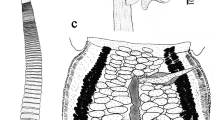Abstract
Our helminthological examination of murid rodents on Luzon Island, Philippines, revealed a remarkable diversity of Hymenolepis Weinland, 1858. Here we describe two new species based on specimens from murid rodents Rattus everetti (Günther) and Apomys datae (Meyer) collected from Luzon Island. Hymenolepis alterna n. sp. differs from all known species of Hymenolepis in having irregularly alternating genital pores. This feature has not been reported from any previously known member of Hymenolepis. Additionally, Hymenolepis alterna n. sp. also differs from other Hymenolepis spp. in the relative position of both poral and antiporal dorsal osmoregulatory canals which are shifted towards the middle of the proglottis in relation to the ventral canals on both sides of the proglottides, and in having curved or twisted external seminal vesicle, covered externally by a dense layer of intensely stained cells. Hymenolepis bilaterala n. sp. differs from all known species of Hymenolepis in the relative position of both poral and antiporal dorsal osmoregulatory canals, which are shifted bilaterally towards the margins of proglottides in relation to the ventral canals, and in possession of testes situated in a triangle and eggs with very thin outer coat. A total of seven species of Hymenolepis are known from the Philippine archipelago. This total includes the cosmopolitan species Hymenolepis diminuta (Rudolphi, 1819), which was likely introduced to the island with invasive rats. Strikingly, all seven known species occur on the island of Luzon alone. By comparison, only six Hymenolepis spp. are known from the whole Palaearctic and seven from the Nearctic despite a much better level of knowledge of rodent helminths in these zoogeographical regions, as well as vast territories, diverse landscapes and very rich rodent fauna. This suggests that Hymenolepis spp. may have undergone an unusually active radiation in the Philippines. Possible explanations of this phenomenon are discussed.




Similar content being viewed by others
References
Greiman, S. E., & Tkach, V. V. (2012). Description and phylogenetic relationships of Rodentolepis gnoskei n. sp. (Cyclophyllidea: Hymenolepididae) from a shrew Suncus varilla minor in Malawi. Parasitology International, 61, 343–350.
Gulyaev, V. D., & Mel’nikova, Y. A. (2005). [New genus of Cestoda from moles Talpolepis gen. n. and the redescription of T. peipingensis (Hsü, 1935) comb. n. (Cyclophyllidea: Hymenolepididae)]. In: Problems of Cestodology III, pp. 130–139 (In Russian).
Haukisalmi, V., Hardman, L. M., Foronda, P., Feliu, C., Laakkonen, J., Niemimaa, J., Lehtonen, J. T., & Henttonen, H. (2010). Systematic relationships of hymenolepidid cestodes of rodents and shrews inferred from sequences of 28S ribosomal RNA. Zoologica Scripta, 39, 631–641.
Heaney, L., Piper, P., & Mijares, A. S. B. (2011). The first fossil record of endemic murid rodents from the Philippines: A late Pleistocene cave fauna from Northern Luzon. Proceedings of the Biological Society of Washington, 124, 234–247.
Hunkeler, P. (1972). Les cestodes parasites des petits mammifères (Rongeurs et Insectivores) de Côte-d’Ivoire et de Haute-Volta (Note préliminaire). Bulletin de la Société Neuchateloise des Sciences Naturelles, 95, 121–132.
Jansa, S. A., Barker, F. K., & Heaney, L. R. (2006). The pattern and timing of diversification of Philippine endemic rodents: evidence from mitochondrial and nuclear gene sequences. Systematic Biology, 55, 73–88.
Makarikov, A. A., & Tkach, V. V. (2013). Two new species of Hymenolepis (Cestoda: Hymenolepididae) from Spalacidae and Muridae (Rodentia) from eastern Palaearctic. Acta Parasitologica, 58, 37–49.
Makarikov, A. A., Tkach, V. V., & Bush, S. E. (2013). Two new species of Hymenolepis (Cestoda: Hymenolepididae) from murid rodents (Rodentia: Muridae) in the Philippines. Journal of Parasitology, 99, 847–855.
Makarikova, T. A., Gulyaev, V. D., Tiunov, M. P., & Feng, Jiang. (2010). [Cestodes Paramilina nishidai (Sawada 1982) gen. n., comb. n. and Hymenolepis magna sp. n. (Cyclophyllidea: Hymenolepididae) from Chiroptera in China.] Zoolgicheskii Zhurnal, 89, 131–139 (In Russian).
Makarikova, T. A., & Makarikov, A. A. (2012). First report of Potorolepis Spassky, 1994 (Eucestoda: Hymenolepididae) from China, with description of a new species in bats (Chiroptera: Rhinolophidae). Folia Parasitologica, 59, 272–278.
Mas-Coma, S., & Tenora, F. (1997). Proposal of Arostrilepis n. gen. (Cestoda: Hymenolepididae). Research and Reviews in Parasitology, 57, 93–101.
Tubangui, M. A. (1931). Worm parasites of the brown rat (Mus norvegicus) in the Philippine Islands, with special reference to those forms that may be transmitted to human beings. Philippine Journal of Science, 46, 537–591.
Wilson, D. E., & Reeder, D. M. (Eds) (2005). Mammal Species of the World: A Taxonomic and Geographic Reference. Third Edition. Baltimore: The Johns Hopkins University Press.
Acknowledgements
We thank Dr Jean Mariaux (Natural History Museum, Geneva, Switzerland), for providing conditions and laboratory space for examination of the type-series of Hymenolepis uranomydis. We also thank the Protected Areas and Wildlife Bureau (PAWB) of the Philippine Department of Environment and Natural Resources (DENR) for supporting our biodiversity research and our field counterparts for assistance in the fieldwork. Dr. Arvin Diesmos (National Museum of the Philippines) and Dr. Rafe Brown (University of Kansas) were instrumental in organization and logistic support of the collecting trips. Dr. Jacob Esselstyn (Louisiana State University, Baton Rouge) identified the rodent hosts of the cestodes. We thank two anonymous reviewers for detailed comments that improved the manuscript. This study was supported by the National Science Foundation (grants DEB 0818696 and DEB 0743491). Research by AAM was supported in part by the Russian Fund for Fundamental Research (Project No. 14-04-00871-a).
Author information
Authors and Affiliations
Corresponding author
Rights and permissions
About this article
Cite this article
Makarikov, A.A., Tkach, V.V., Villa, S.M. et al. Description of two new species of Hymenolepis Weinland, 1858 (Cestoda: Hymenolepididae) from rodents on Luzon Island, Philippines. Syst Parasitol 90, 27–37 (2015). https://doi.org/10.1007/s11230-014-9528-x
Received:
Accepted:
Published:
Issue Date:
DOI: https://doi.org/10.1007/s11230-014-9528-x




